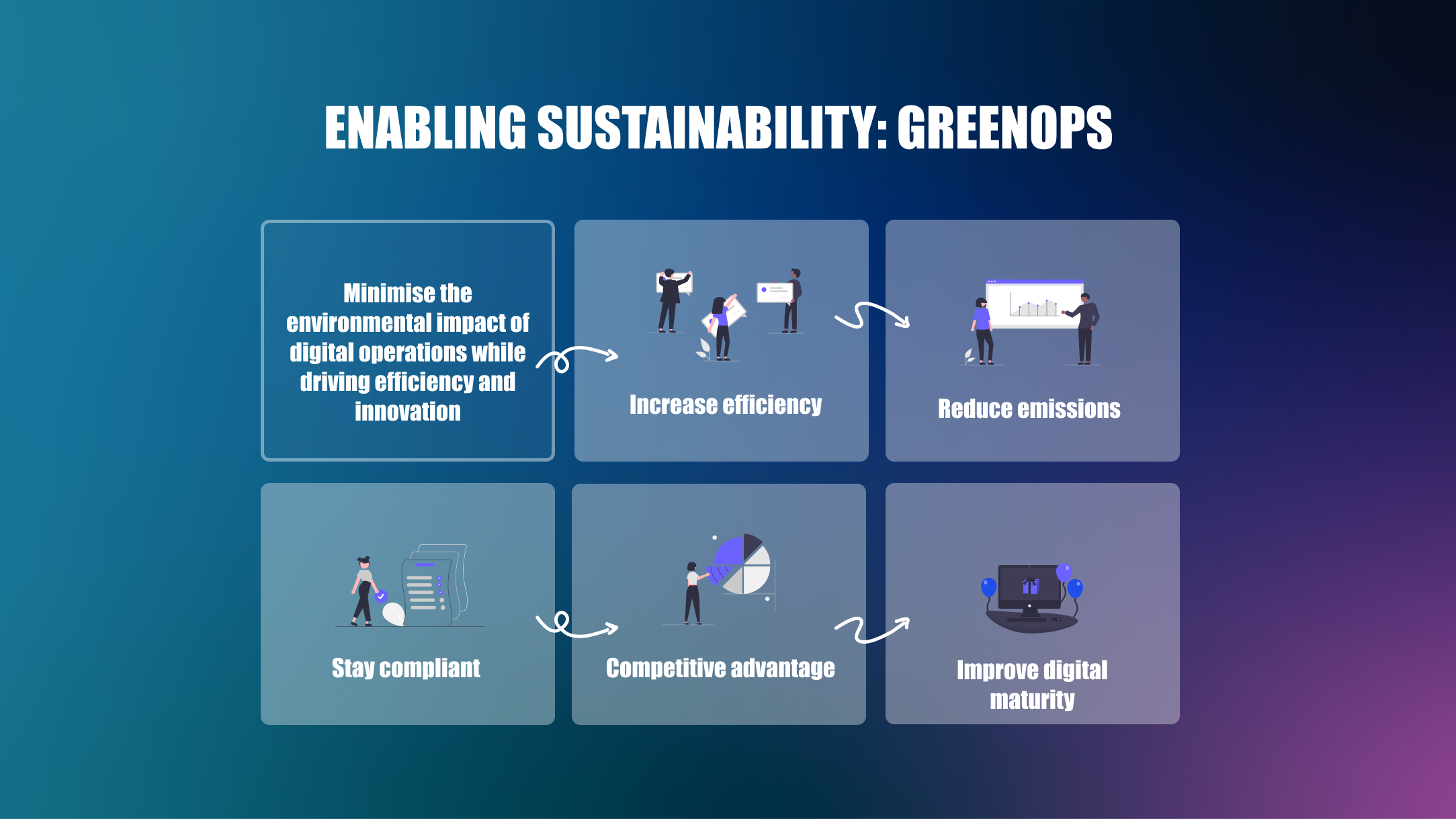With upcoming regulation such as the European Union’s Corporate Sustainability Reporting Directive (CSRD), organisations will be compelled to not only report on their emissions, but also have credible carbon reduction plans.
Digital technology represents a significant part of many organisations’ carbon footprints. Embedding GreenOps can not only help organisations be more efficient, reduce emissions and stay compliant, it can also be a competitive advantage and help improve overall digital maturity.
What is GreenOps?
GreenOps (short for Green Operations) is the integration of sustainable practices and principles into the operational processes of an organisation. It focuses on minimising the environmental impact of digital operations while driving efficiency and innovation. GreenOps is akin to FinOps (Financial Operations) and uses carbon emissions and environmental impact instead of cost as a driver for efficiency. Ultimately, GreenOps is about doing more with less carbon emissions. Leaner really does mean greener as well as faster and cheaper.
Like FinOps, GreenOps takes inspiration from the Lean continuous improvement methodology in that it focuses on learning and reducing waste – in this case, emissions – through the application of technology and automation. As the famous Peter Drucker quote goes “you can’t manage what you don’t measure” so as part of any GreenOps initiatives, it’s vital to establish an emissions baseline and have a consistent way of measuring emissions so you can track the impact you are having. Measuring the emissions from digital technology has historically been hard and it still is a challenge, but cloud providers are starting to make it easier, and there are organisations and services that are emerging to help fill the gaps.
However, GreenOps doesn’t need to start with emission data. With digital technology, consumption is a good proxy for emissions. Consumption is usually measured in terms of compute, memory, storage and bandwidth and again, it’s easier to measure if you are already in the cloud. Cost is also a proxy for emissions. Although it’s not as good as consumption, since reducing cost through things like saving plans or purchasing reserved instances do not actually reduce your emissions as they do not change what you actually use. Reserved instances relating to providers who will often give you a cheaper rate if you commit to use a service – i.e. reserve it – for a certain period of time. In addition, most Software-as-a-Service (SaaS) services operate a licensing model where cost does not always equal consumption.
Whether you are using emissions or consumption as a proxy, many GreenOps optimisations can be self-evident including:
- Rightsizing – downsizing servers to the most appropriate size for the workload they need to perform e.g. don’t use a server with 8 CPUs when 4 will do. Not only will it be cheaper, but it will also use fewer resources and emit less carbon.
- Autoscaling – scaling up and down with demand rather than always running for peak load. Using serverless technology is significantly more efficient for variable workloads.
- Retention – only keeping what you need for as long as you actually need it rather than keeping everything forever.
- Compression – reducing the amount of storage required by compressing data.
Other optimisations may be less obvious. For example, sustainable demand shifting is the process of dynamically changing the location or the timing of processing to make it more efficient. To illustrate, processing could be moved to regions with a higher percentage of renewable energy (known as having a lower carbon intensity) or processing could be delayed until the carbon intensity in a region is lower.
Services such as WattTime (https://www.watttime.org/) and ElectricityMaps (https://app.electricitymaps.com/) provide near real-time and historical information on carbon intensity across the globe, allowing engineers to build systems that can take this information into account when running workloads.
Automation and AI also play a key role in GreenOps. Manual effort is almost always less efficient and automating activity – particularly when it comes to analysing and optimising workloads – can also make a significant difference.
Conclusion
Building a GreenOps capability is critical to driving carbon efficiency across an organisation’s digital operations and it is possible to start today, ahead of any efforts to measure and baseline emissions, by focusing on reducing consumption. Engaging engineers, upskilling, motivating and incentivising them to reduce emissions is an essential part of GreenOps, and it will not only help reduce emissions but also reduce costs and drive innovation.
Partnering with FSP for a Sustainable Future
If you want to explore other enablers for achieving sustainable digital transformation, we invite you to check out our white paper which also contains pragmatic advice for digital leaders looking to find out more about sustainability and how it can benefit their transformation initiatives. Feel free to get in touch with us at sustainability@fsp.co to find out more about these topics and discuss how we can help your organisation thrive in the realm of sustainability.

